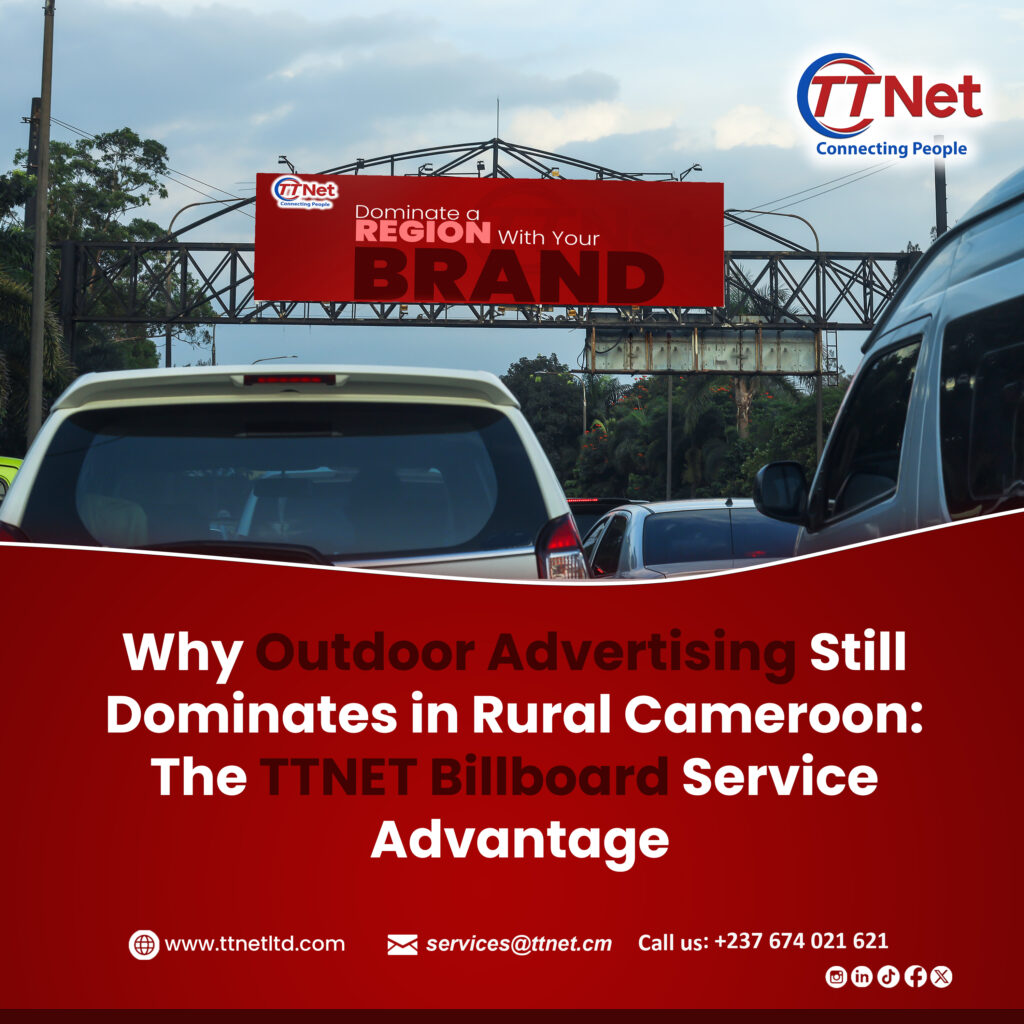
Introduction: The Media Landscape in Rural Cameroon
In the heart of Central Africa, Cameroon’s rural regions, home to over 40% of its population, remain deeply connected to traditional modes of communication. While urban centers like Douala and Yaoundé buzz with digital billboards and social media campaigns, rural areas rely on time-tested methods to share information. Among these, outdoor advertising, particularly billboards, stands out as a cornerstone of community engagement. This blog explores why outdoor advertising continues to thrive in rural Cameroon and how TTNET Billboard Service has mastered this medium to deliver unmatched results for businesses.
1. The Enduring Power of Outdoor Advertising
1.1 Limited Digital Infrastructure
Rural Cameroon faces significant challenges in digital connectivity. According to a 2022 report by Cameroon’s Telecommunications Regulatory Board, only 22% of rural residents have consistent internet access, compared to 65% in urban areas. This digital divide makes online campaigns ineffective for reaching populations dependent on agriculture and local trade. TTNET Billboard Service fills this gap by providing physical advertisements in high-traffic zones, ensuring messages reach audiences where they live, work, and gather.
1.2 High Visibility and Reach
Billboards command attention in areas where daily life revolves around communal spaces. Markets, bus stations, and roadside stalls become prime advertising real estate. A single TTNET billboard in a village market can attract thousands of weekly viewers, from farmers selling produce to families shopping for essentials. Unlike fleeting digital ads, these static displays remain visible 24/7, embedding brands into the local landscape.
1.3 Cultural Resonance and Trust
In communities where oral traditions and face-to-face interactions prevail, tangible advertisements foster trust. A vibrant TTNET billboard for a local microfinance institution or farm supply store feels more credible than a digital ad, which may be perceived as impersonal or irrelevant. As Paul Nkeng, a farmer in the Northwest Region, explains: “When I see a billboard for fertilizer, I know the company is invested here. It’s not just a pop-up on a phone.”
1.4 Cost-Effectiveness for Local Businesses
Small and medium enterprises (SMEs) dominate rural Cameroon’s economy. For these businesses, digital ads, requiring tech expertise and recurring fees, are often impractical. TTNET offers affordable, one-time installation costs, with durable materials that withstand tropical weather. A bakery in Bamenda reported a 30% sales increase after a six-month billboard campaign, citing visibility and budget-friendliness as key factors.
1.5 Local Language Adaptation
Cameroon’s linguistic diversity includes over 200 local languages. TTNET’s use of regional dialects and culturally resonant imagery ensures messages resonate deeply. For example, a billboard in the West Region promoting malaria prevention might use Medumba language phrases and visuals of local healthcare workers, bridging communication gaps that English or French cannot.
2. TTNET Billboard Service: Tailored for Rural Success
2.1 Strategic Placement and Coverage
TTNET’s extensive network spans 80% of Cameroon’s rural districts, with billboards positioned along highways, near schools, and at market entrances. Their team conducts site surveys to maximize foot traffic, ensuring clients’ messages reach the right eyes. A case study in the Littoral Region showed a 50% higher engagement rate for billboards placed near motorcycle taxi stands, a hub for daily commuters.
2.2 Durability and Maintenance
Cameroon’s rainy seasons and harsh sunlight demand rugged materials. TTNET uses weather-resistant vinyl and reinforced steel frames, with monthly maintenance checks to prevent wear. This reliability builds client trust; as noted by a TTNET client, “Our billboard stayed intact through two rainy seasons, no fading or damage.”
2.3 Hyper-Local Customization
TTNET collaborates with local artists and translators to design campaigns that reflect community values. When a cooperative in the Adamawa Region launched a billboard for organic honey, TTNET incorporated Fulfulde proverbs and imagery of regional flora, resulting in a 40% membership boost within three months.
2.4 Case Study: Njangi Fund Revival
A community savings group in the Southwest Region partnered with TTNET to attract new members. Billboards featuring testimonials from local farmers and meeting schedules were placed near churches and water points. Within six months, membership grew from 50 to 200, highlighting the power of location-specific messaging.
3. Outdoor vs. Digital: Why the Former Wins (For Now)
While global trends favor digital, rural Cameroon’s context favors outdoor. Smartphone penetration remains low (under 35%), and electricity shortages limit screen time. Moreover, elders, key decision-makers in rural households, prefer physical ads. TTNET bridges generational gaps, though future integration with mobile campaigns (e.g., QR codes on billboards) could blend tradition with innovation.
4. Future Outlook: Innovation Within Tradition
TTNET is exploring solar-powered digital billboards for towns with intermittent electricity. However, the core strength remains static billboards, which require no infrastructure. As 4G expands, TTNET’s hybrid model, combining outdoor ads with SMS follow-ups, could redefine rural marketing.
Conclusion: Why TTNET Billboards Are the Smart Choice
In rural Cameroon, outdoor advertising isn’t just a relic, it’s a lifeline. TTNET Billboard Service excels by aligning with cultural, economic, and environmental realities. For businesses seeking lasting impact, TTNET offers visibility, credibility, and adaptability unmatched by digital alternatives.
Call to Action*
Ready to connect with rural Cameroon? Visit TTNET Billboard Service today to design a campaign that stands the test of time, and terrain.

